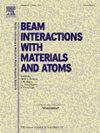Performance testing a portable 109Cd XRF system for the measurement of ex vivo skin iron content in a rat model of iron overload
IF 1.4
3区 物理与天体物理
Q3 INSTRUMENTS & INSTRUMENTATION
Nuclear Instruments & Methods in Physics Research Section B-beam Interactions With Materials and Atoms
Pub Date : 2025-04-09
DOI:10.1016/j.nimb.2025.165696
引用次数: 0
Abstract
The ability of a 109Cd-based portable X-ray fluorescence (109Cd pXRF) system to differentiate iron (Fe) levels in the ex vivo skin of 28 rats dosed with Fe2+ via intraperitoneal injection has been tested. The 28 animals included control rats and those dosed with either 80 mg Fe2+/kg or 160 mg Fe2+/kg. The system was able to distinguish between groups of control and dosed rats based on their measured skin iron concentration (p = 0.001 and p = 0.002). Further, linear regression analysis of individual rat skin Fe levels against Fe2+ dose in mg/kg showed a strong correlation (r2 = 0.84, p < 0.0001) and indicated that the system could determine whether individual animals had been dosed with Fe. Strong correlation (r2 = 0.85, p < 0.0001) between the 109Cd pXRF system skin Fe measurements and skin Fe measurements using a laboratory-based XRF system (which had previously shown a correlation between skin Fe and with liver Fe) suggest that 109Cd pXRF measurements could be used to predict elevated Fe levels in the liver.
便携式109Cd XRF系统在铁超载大鼠模型中测量离体皮肤铁含量的性能测试
我们测试了基于 109Cd 的便携式 X 射线荧光(109Cd pXRF)系统区分 28 只通过腹腔注射服用了 Fe2+ 的大鼠体内外皮肤中铁(Fe)含量的能力。这 28 只动物包括对照组大鼠和注射 80 毫克 Fe2+/kg 或 160 毫克 Fe2+/kg 的大鼠。该系统能够根据测得的皮肤铁浓度(p = 0.001 和 p = 0.002)区分对照组和用药组。此外,个体大鼠皮肤铁含量与 Fe2+ 剂量(毫克/千克)的线性回归分析显示出很强的相关性(r2 = 0.84,p < 0.0001),表明该系统可以确定动物个体是否被添加了铁。109Cd pXRF 系统皮肤铁测量值与使用实验室 XRF 系统进行的皮肤铁测量值之间的强相关性(r2 = 0.85,p < 0.0001)(该系统以前曾显示皮肤铁与肝脏铁之间存在相关性)表明,109Cd pXRF 测量值可用于预测肝脏中铁含量的升高。
本文章由计算机程序翻译,如有差异,请以英文原文为准。
求助全文
约1分钟内获得全文
求助全文
来源期刊
CiteScore
2.80
自引率
7.70%
发文量
231
审稿时长
1.9 months
期刊介绍:
Section B of Nuclear Instruments and Methods in Physics Research covers all aspects of the interaction of energetic beams with atoms, molecules and aggregate forms of matter. This includes ion beam analysis and ion beam modification of materials as well as basic data of importance for these studies. Topics of general interest include: atomic collisions in solids, particle channelling, all aspects of collision cascades, the modification of materials by energetic beams, ion implantation, irradiation - induced changes in materials, the physics and chemistry of beam interactions and the analysis of materials by all forms of energetic radiation. Modification by ion, laser and electron beams for the study of electronic materials, metals, ceramics, insulators, polymers and other important and new materials systems are included. Related studies, such as the application of ion beam analysis to biological, archaeological and geological samples as well as applications to solve problems in planetary science are also welcome. Energetic beams of interest include atomic and molecular ions, neutrons, positrons and muons, plasmas directed at surfaces, electron and photon beams, including laser treated surfaces and studies of solids by photon radiation from rotating anodes, synchrotrons, etc. In addition, the interaction between various forms of radiation and radiation-induced deposition processes are relevant.

 求助内容:
求助内容: 应助结果提醒方式:
应助结果提醒方式:


